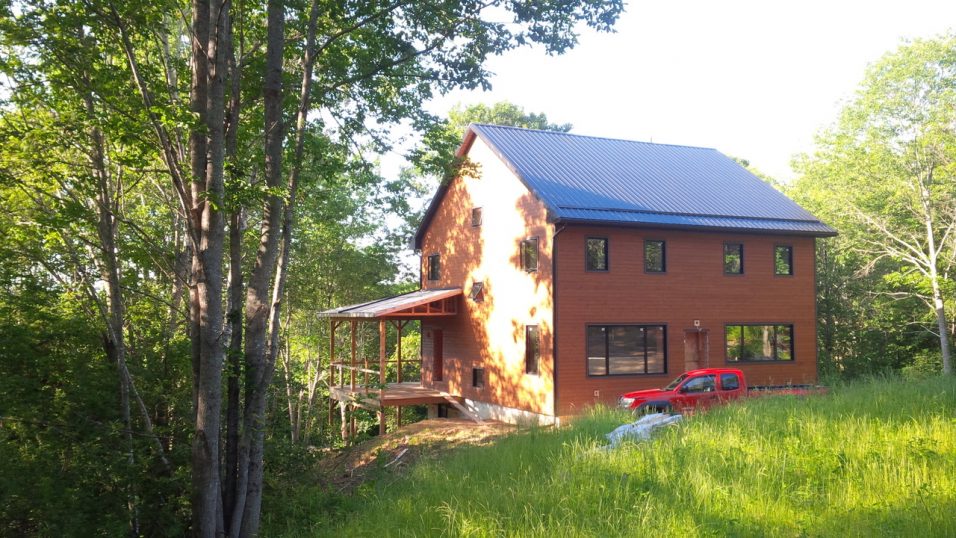Home Sweet Passive Home: A Passive House in the Gaspereau Valley
By Genevieve Allen Hearn
To recognize Earth Day on April 22, The Grapevine interviewed Phil Dennis about one of the most energy efficient homes in the Valley. Phil, his wife Mary Sweatman, and their two sons live in a custom-built, 2,500 square foot passive home in the Gaspereau Valley.
The Grapevine (GV): What does passive house design mean?
Phil Dennis (PD): Passive house is a standard of construction that sets limits on energy consumption and air leakage. Passive house isn’t really passive at all; the concept relies on active ventilation systems. It often confuses people who have known about passive solar design, which has a dominant solar strategy, usually combined with a high level of thermal mass.
Passive House is considered to be the most rigorous voluntary energy-based standard in the design and construction industry today. If a building is to achieve year-round comfort in a cold or cool climate zone, but with minimal heating & cooling energy usage, some key fundamentals must be followed:
Pre-Planning: I studied the International Passive House standard, and obtained my passive house designer certification. I also consulted experienced passive house builders, designers, and industry leaders.
Efficient Building Shape: Heat loss from the building envelope is proportional to its surface area. We designed using a simple shape (roughly a cube), instead of a sprawling design.
Solar Exposure: Utilize south-facing glazing, minimize north facades, and incorporate shading strategies. We placed our main living space on the south side of the house, with windows sized to optimize solar gain.
Superinsulation: Given the climate in Canada, insulation levels are likely required to be three to seven times higher than national and provincial standards. We insulated under our slab with rigid foam (R40), used mineral wool & dense-pack cellulose in our walls (R60), and loose-fill cellulose in our roof (R110).
Advanced Windows: Triple-pane windows are essential in Canada, with low-e coatings, argon gas fill, insulated spacers, and insulated frames. Most windows currently sold in Canada meet few, if any, of these requirements.
Airtightness: A high-level of airtightness is required to minimize heat loss from air infiltration, and to provide protection against moisture damage. We achieved a blower door test value that is approximately three times better than the maximum allowable according to the Passive House standard.
Ventilation with Heat Recovery: Essential for excellent indoor air quality (temperature & humidity) and heat recovery, with frost protection using pre-heating. We installed a high-efficiency HRV/ERV system from Europe, and have had the entire system balanced to ensure optimized ventilation throughout the house.
Thermal Bridge-Free Construction: We were very careful in how we handled every service penetration through the building envelope, minimized the number of exterior corners in our design, and simplified all connections from slab to roof.
GV: Are there any other houses that follow the passive house standards in the area?
PD: There are likely a handful of projects in the area. I am aware of a two specifically: a single dwelling on West Brooklyn Mountain Road, and the Valley Waste Resource Management Building.
GV: Is it more costly than traditional builds?*
PD: Compared to conventional building methods, a passive house can certainly be affordable. It depends on several factors: climate, cost and availability of quality materials, the type of building, knowledge of those involved, etc. The incremental cost to build a passive house, relative to its conventional equivalent, is generally around 10-15%. In my opinion, a passive house is a good investment, due to lower heating & cooling costs, higher indoor air quality and comfort, and security against rising energy prices.
GV: What compelled you to build a passive house?
PD: I always wanted to build a house for my family. As a professional engineer, I was interested in the technical challenge, and was intrigued by the benefits this approach to building offered: high indoor air quality, increased thermal comfort, better sound insulation, high energy efficiency, design durability, and low-maintenance.
I was also very interested in exploring a new career path upon moving back to Nova Scotia. Since completing my engineering degree, I worked primarily in the aerospace industry, and wanted to focus on something different. The goal of building a passive house not only allowed me to build a home, but also provided an opportunity to educate myself and to obtain first-hand experience of a largely untapped market. With the new information that I have acquired, my plan is to provide engineering consulting and passive house support services locally.
If you have any questions about passive house design, feel free to email Phil at pcdennis@gmail.com
